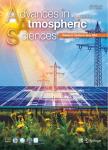AN INSTABILITY THEORY OF AIR-SEA INTERACTION FOR COASTAL UPWELLING
AN INSTABILITY THEORY OF AIR-SEA INTERACTION FOR COASTAL UPWELLING作者机构:Department of Oceanography Naval Postgraduate School Monterey USA
出 版 物:《Advances in Atmospheric Sciences》 (大气科学进展(英文版))
年 卷 期:1988年第5卷第3期
页 面:277-285页
学科分类:07[理学] 070601[理学-气象学] 0706[理学-大气科学] 0816[工学-测绘科学与技术] 0825[工学-航空宇航科学与技术]
主 题:mode AN INSTABILITY THEORY OF AIR-SEA INTERACTION FOR COASTAL UPWELLING length SEA
摘 要:A surface wind (seabreeze), thermally generated by differential sea surface temperature, is introduced to Gill-Clarke’s model (1974) through wind stress for investigating the effects of seabreeze on coastal upwel-ling. A coupled air-sea system is treated as an eigenvalue problem. The solutions show that the thermally forced local winds break down the coastal Kelvin wave into three parts: small-scale (L200 km) coastal Kelvin modes. The consistency of the length scale between the most growing mode predicted by this model and the observed cold/warm alternation pattern of surface water near the Peruvian Coast (around 15 °S) implies that seabreeze may play some role in coastal upwelling.



